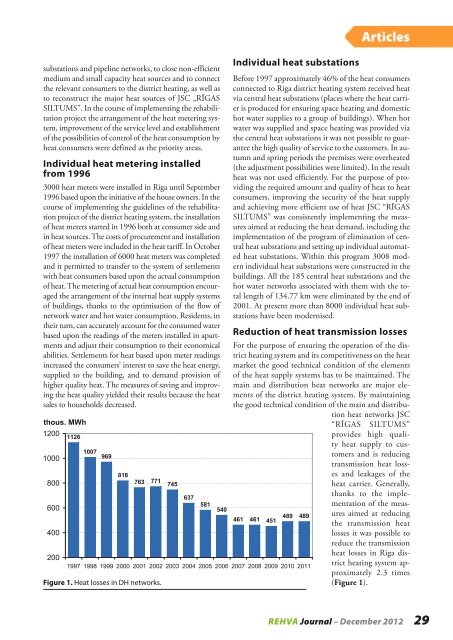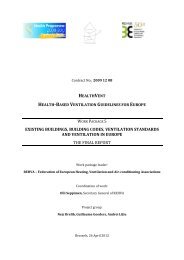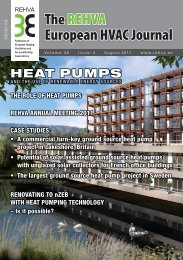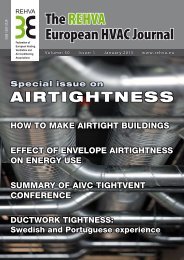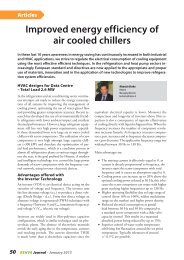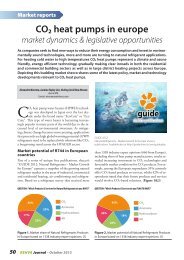Use of biofuels in the district heating system of Riga - rehva
Use of biofuels in the district heating system of Riga - rehva
Use of biofuels in the district heating system of Riga - rehva
Create successful ePaper yourself
Turn your PDF publications into a flip-book with our unique Google optimized e-Paper software.
substations and pipel<strong>in</strong>e networks, to close non-efficient<br />
medium and small capacity heat sources and to connect<br />
<strong>the</strong> relevant consumers to <strong>the</strong> <strong>district</strong> heat<strong>in</strong>g, as well as<br />
to reconstruct <strong>the</strong> major heat sources <strong>of</strong> JSC „RĪGAS<br />
SILTUMS”. In <strong>the</strong> course <strong>of</strong> implement<strong>in</strong>g <strong>the</strong> rehabilitation<br />
project <strong>the</strong> arrangement <strong>of</strong> <strong>the</strong> heat meter<strong>in</strong>g <strong>system</strong>,<br />
improvement <strong>of</strong> <strong>the</strong> service level and establishment<br />
<strong>of</strong> <strong>the</strong> possibilities <strong>of</strong> control <strong>of</strong> <strong>the</strong> heat consumption by<br />
heat consumers were def<strong>in</strong>ed as <strong>the</strong> priority areas.<br />
Individual heat meter<strong>in</strong>g <strong>in</strong>stalled<br />
from 1996<br />
3000 heat meters were <strong>in</strong>stalled <strong>in</strong> <strong>Riga</strong> until September<br />
1996 based upon <strong>the</strong> <strong>in</strong>itiative <strong>of</strong> <strong>the</strong> house owners. In <strong>the</strong><br />
course <strong>of</strong> implement<strong>in</strong>g <strong>the</strong> guidel<strong>in</strong>es <strong>of</strong> <strong>the</strong> rehabilitation<br />
project <strong>of</strong> <strong>the</strong> <strong>district</strong> heat<strong>in</strong>g <strong>system</strong>, <strong>the</strong> <strong>in</strong>stallation<br />
<strong>of</strong> heat meters started <strong>in</strong> 1996 both at consumer side and<br />
<strong>in</strong> heat sources. The costs <strong>of</strong> procurement and <strong>in</strong>stallation<br />
<strong>of</strong> heat meters were <strong>in</strong>cluded <strong>in</strong> <strong>the</strong> heat tariff. In October<br />
1997 <strong>the</strong> <strong>in</strong>stallation <strong>of</strong> 6000 heat meters was completed<br />
and it permitted to transfer to <strong>the</strong> <strong>system</strong> <strong>of</strong> settlements<br />
with heat consumers based upon <strong>the</strong> actual consumption<br />
<strong>of</strong> heat. The meter<strong>in</strong>g <strong>of</strong> actual heat consumption encouraged<br />
<strong>the</strong> arrangement <strong>of</strong> <strong>the</strong> <strong>in</strong>ternal heat supply <strong>system</strong>s<br />
<strong>of</strong> build<strong>in</strong>gs, thanks to <strong>the</strong> optimisation <strong>of</strong> <strong>the</strong> flow <strong>of</strong><br />
network water and hot water consumption. Residents, <strong>in</strong><br />
<strong>the</strong>ir turn, can accurately account for <strong>the</strong> consumed water<br />
based upon <strong>the</strong> read<strong>in</strong>gs <strong>of</strong> <strong>the</strong> meters <strong>in</strong>stalled <strong>in</strong> apartments<br />
and adjust <strong>the</strong>ir consumption to <strong>the</strong>ir economical<br />
abilities. Settlements for heat based upon meter read<strong>in</strong>gs<br />
<strong>in</strong>creased <strong>the</strong> consumers’ <strong>in</strong>terest to save <strong>the</strong> heat energy,<br />
supplied to <strong>the</strong> build<strong>in</strong>g, and to demand provision <strong>of</strong><br />
higher quality heat. The measures <strong>of</strong> sav<strong>in</strong>g and improv<strong>in</strong>g<br />
<strong>the</strong> heat quality yielded <strong>the</strong>ir results because <strong>the</strong> heat<br />
sales to households decreased.<br />
thous. MWh<br />
1200<br />
1000<br />
800<br />
600<br />
400<br />
200<br />
1126<br />
1007 969<br />
818<br />
Figure 1. Heat losses <strong>in</strong> DH networks.<br />
763 771 745<br />
637<br />
Individual heat substations<br />
Before 1997 approximately 46% <strong>of</strong> <strong>the</strong> heat consumers<br />
connected to <strong>Riga</strong> <strong>district</strong> heat<strong>in</strong>g <strong>system</strong> received heat<br />
via central heat substations (places where <strong>the</strong> heat carrier<br />
is produced for ensur<strong>in</strong>g space heat<strong>in</strong>g and domestic<br />
hot water supplies to a group <strong>of</strong> build<strong>in</strong>gs). When hot<br />
water was supplied and space heat<strong>in</strong>g was provided via<br />
<strong>the</strong> central heat substations it was not possible to guarantee<br />
<strong>the</strong> high quality <strong>of</strong> service to <strong>the</strong> customers. In autumn<br />
and spr<strong>in</strong>g periods <strong>the</strong> premises were overheated<br />
(<strong>the</strong> adjustment possibilities were limited). In <strong>the</strong> result<br />
heat was not used efficiently. For <strong>the</strong> purpose <strong>of</strong> provid<strong>in</strong>g<br />
<strong>the</strong> required amount and quality <strong>of</strong> heat to heat<br />
consumers, improv<strong>in</strong>g <strong>the</strong> security <strong>of</strong> <strong>the</strong> heat supply<br />
and achiev<strong>in</strong>g more efficient use <strong>of</strong> heat JSC “RĪGAS<br />
SILTUMS” was consistently implement<strong>in</strong>g <strong>the</strong> measures<br />
aimed at reduc<strong>in</strong>g <strong>the</strong> heat demand, <strong>in</strong>clud<strong>in</strong>g <strong>the</strong><br />
implementation <strong>of</strong> <strong>the</strong> program <strong>of</strong> elim<strong>in</strong>ation <strong>of</strong> central<br />
heat substations and sett<strong>in</strong>g up <strong>in</strong>dividual automated<br />
heat substations. With<strong>in</strong> this program 3008 modern<br />
<strong>in</strong>dividual heat substations were constructed <strong>in</strong> <strong>the</strong><br />
build<strong>in</strong>gs. All <strong>the</strong> 185 central heat substations and <strong>the</strong><br />
hot water networks associated with <strong>the</strong>m with <strong>the</strong> total<br />
length <strong>of</strong> 134.77 km were elim<strong>in</strong>ated by <strong>the</strong> end <strong>of</strong><br />
2001. At present more than 8000 <strong>in</strong>dividual heat substations<br />
have been modernised.<br />
Reduction <strong>of</strong> heat transmission losses<br />
For <strong>the</strong> purpose <strong>of</strong> ensur<strong>in</strong>g <strong>the</strong> operation <strong>of</strong> <strong>the</strong> <strong>district</strong><br />
heat<strong>in</strong>g <strong>system</strong> and its competitiveness on <strong>the</strong> heat<br />
market <strong>the</strong> good technical condition <strong>of</strong> <strong>the</strong> elements<br />
<strong>of</strong> <strong>the</strong> heat supply <strong>system</strong>s has to be ma<strong>in</strong>ta<strong>in</strong>ed. The<br />
ma<strong>in</strong> and distribution heat networks are major elements<br />
<strong>of</strong> <strong>the</strong> <strong>district</strong> heat<strong>in</strong>g <strong>system</strong>. By ma<strong>in</strong>ta<strong>in</strong><strong>in</strong>g<br />
<strong>the</strong> good technical condition <strong>of</strong> <strong>the</strong> ma<strong>in</strong> and distribution<br />
heat networks JSC<br />
“RĪGAS SILTUMS”<br />
provides high quality<br />
heat supply to customers<br />
and is reduc<strong>in</strong>g<br />
transmission heat losses<br />
and leakages <strong>of</strong> <strong>the</strong><br />
heat carrier. Generally,<br />
thanks to <strong>the</strong> implementation<br />
<strong>of</strong> <strong>the</strong> measures<br />
aimed at reduc<strong>in</strong>g<br />
489 489<br />
<strong>the</strong> transmission heat<br />
losses it was possible to<br />
reduce <strong>the</strong> transmission<br />
heat losses <strong>in</strong> <strong>Riga</strong> <strong>district</strong><br />
heat<strong>in</strong>g <strong>system</strong> approximately<br />
2.3 times<br />
(Figure 1).<br />
581<br />
540<br />
461 461 451<br />
1997 1998 1999 2000 2001 2002 2003 2004 2005 2006 2007 2008 2009 2010 2011<br />
Articles<br />
REHVA Journal – December 2012 29


